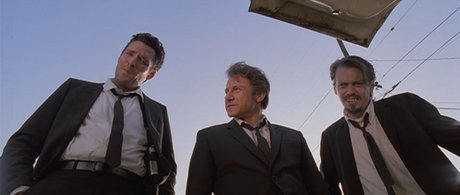Camera Angles
Camera Angles
As well as Shot Types you have camera angles that co inside with the shot types. There are 5 Main types of Camera Angles, they are; The Birds-eye view, High Angle, Eye Level, Low Angle, Oblique/Canted.
The Birds-eye view
This camera angle shows a scene from directly above the subject(s). It is a strange angle as many objects from this angle are unrecognisable such as umbrellas in a crowd or dancers legs'. The use of this angle is to put the audience in a position of dominance and or higher power, godlike. The subjects may seem ant like giving them minimal significance, or to be shown as part of a greater scheme such as war.
High angle
This camera angle is a lot less extreme compared to a birds-eye view due to the large difference in altitude. The camera may be held by a crane to give an overview of the general scene. The subject(s) are still less significant or it may be used to make the subject(s) feel fear as they are below a more dominant force. This makes them swallowed in the action that is being hidden from the angle and are shown to be apart of a greater picture.

Eye Level
This shot is fairly neutral. The camera is placed at this angle to put you in a position of a person actually observing something swell. It can keep something hidden from the audience if faced towards the actors face. It makes the audience feel as if something is greater to them as they are put in the shoes of the actor. Usually the shot type is a medium close up which combines with the eye level angle to give an intimate connection and clearly expresses how the subject feels through expressions.

Low angle
This angle will emphasise the height of a subject to give it dominance and make you as a viewer feel insignificant compared to the subject. As an audience we are given powerlessness within large action in a scene. Usually in the background of a low angle is a ceiling or the sky. This lack of detail around the subject makes the audience disorientated and confused.

Oblique/Canted/Dutch angle
In this angle the camera is often found tilted or off angle. It will indicate imbalance and or instability. They can be often found in horror movies but are used a lot in other genres. The angle makes the audience feel nauseous so they are relating to a possible drunk or sick subject. The audience is then able to feel what the subject feels in a truer sense. On the other hand, it can show a crooked scene that can identify unstable people within a scene. It will clearly indicate antagonists and protagonists.

I am yet to experience using a lot of angles as I have been coming to grips with the basics preferably using Eye level shots as they are easier to shoot. In the future I would like to use these other camera angles and see their effect on an audience.

Eye Level
This shot is fairly neutral. The camera is placed at this angle to put you in a position of a person actually observing something swell. It can keep something hidden from the audience if faced towards the actors face. It makes the audience feel as if something is greater to them as they are put in the shoes of the actor. Usually the shot type is a medium close up which combines with the eye level angle to give an intimate connection and clearly expresses how the subject feels through expressions.

Low angle
This angle will emphasise the height of a subject to give it dominance and make you as a viewer feel insignificant compared to the subject. As an audience we are given powerlessness within large action in a scene. Usually in the background of a low angle is a ceiling or the sky. This lack of detail around the subject makes the audience disorientated and confused.

Oblique/Canted/Dutch angle
In this angle the camera is often found tilted or off angle. It will indicate imbalance and or instability. They can be often found in horror movies but are used a lot in other genres. The angle makes the audience feel nauseous so they are relating to a possible drunk or sick subject. The audience is then able to feel what the subject feels in a truer sense. On the other hand, it can show a crooked scene that can identify unstable people within a scene. It will clearly indicate antagonists and protagonists.

I am yet to experience using a lot of angles as I have been coming to grips with the basics preferably using Eye level shots as they are easier to shoot. In the future I would like to use these other camera angles and see their effect on an audience.

Another great post Liam! Your own research into the camera angles has proven very sucessful and you have clearly identified the 5 types with some very good examples.
ReplyDeleteI'm currently struggling to see your posts about Mise-en-scene and Sound? Could you please ensure that they are published and that they are labeled Mircoelements. Should you need help with this please ask myself or Luke.